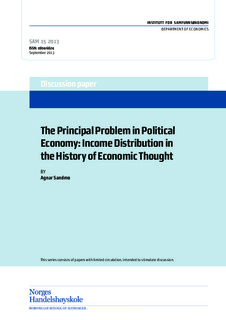The principal problem in political economy : income distribution in the history of economic thought
Working paper
Permanent lenke
http://hdl.handle.net/11250/163454Utgivelsesdato
2013-09Metadata
Vis full innførselSamlinger
- Discussion papers (SAM) [657]
Sammendrag
The paper considers the history of theories of income distribution, from the
time of Adam Smith until the 1970s. It is divided into two main parts. Part I
considers the positive theory of income distribution, beginning with the
classical economists’ analysis of the functional distribution of income between
wages, profits and rent. It goes on to present the new theories that emerged
with the marginalist revolution and which were based on maximizing
behaviour and market equilibrium. The main focus during the early stages of
the new developments was on the markets for consumer goods and the role of
marginal utility in price determination. The later neoclassical economists,
including Alfred Marshall and Knut Wicksell, paid more attention to the
special features that characterized the labour market and the role of marginal
productivity in wage formation. In the 20th century the neoclassical theory was
extended to include analysis of the role of imperfect competition, human
capital and risk-taking. Also included in this part of the paper is a discussion of
statistical and institutional approaches. Part II covers normative theories of
income distribution and their implications for redistributive policy. It begins
2
with a consideration of the value judgements implicit in the policy
recommendations of the classical economists and continues with the attempts
to establish an analytical foundation for welfare economics. The rise of
Paretian welfare theory with its emphasis on the impossibility of interpersonal
comparisons of utility made it difficult to draw conclusions regarding income
redistribution, but the older utilitarian approach, including equal sacrifice
theories, continued to live on in the modern analysis of optimal redistribution.
A short Part III contains some concluding reflections on the position of income
distribution theory within economics as a whole.
